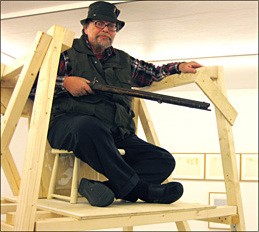
The Sten Hanson Festival
Multimedia
9.10 2010
Stockholm
Stockholm 9 Oct 2010
Place: Auditorium
Admission: 100/80 SEK
Programme
13–13.15 Sten Hanson
13.15-14 Erik Bünger: The third man
14-14.15 Sten Hanson
14.15-14.45 Hanna Hartman: Glücklich auf dem weg nach unten/Happy Going South; dich tholen
14.45-15.15 Julien BLAiNE: CH’i ou Qi
15.15-16 Intermission
16-16.15 Sten Hanson
16.15-16.45 Christina Kubisch: The South – The North/ African voices for Sten Hanson
16.45-17 Sten Hanson
17-17.30 Blood Stereo: A croaking thirst and a healing fluid
17.30-17.45 Sten Hanson
17.45-18.15 Leif Elggren: Oh God it’s too early!
The Festival continues at Fylkingen
19-20 Bar
20- Surprises
The schedule is approximate
Sten Hanson has invited
Julien BLAiNE is born in 1942 in Rognac beside the Étang de Berre, a body of water that was once azure-blue, today chestnut-brown. He lives in , in , in Ventabren and in Marseilles, and he moves around as much as possible. Under a different first name (Rick) he had been born in Casablanca the same year. His mother Vivian, born in 1921, played her biggest role with Laurel and Hardy in Jitterbugs (1943). Big brother of David, and more magical than him! As for him, he stole Barbie from Ken in his youth, under a different name (Guy). Otherwise he has written a few books, had some exhibitions, done some performances and arranged some demonstrations. And of course, he’s also the one who publishes Doc(k)s.
Blood Stereo (Dylan Nyoukis and Karen Constance) is a duo that explores hand-cranked 20th century technology in combination with epiglottal gymnastics and free music modes inherited as much from punk rock’s mutilated aesthetic as utopian art styles.
Erik Bünger is a Swedish artist, composer and writer living in Berlin. He works with recontextualising and remixing media – appropriated from existing music and film – in performances, installations and web projects.
Hanna Hartman is a Swedish soundartist and composer living in Berlin.
Leif Elggren is born by two idiots an enjoys the title of King. He is based in Stockholm, and is running a small record label and a publishing company called Firework. He is also a son of God.
Christina Kubisch is born in Bremen (1948) and has studied painting and composition in Hamburg, Zurich and Milan. She is a professor for audio-visual art at the Academy of Fine Arts, Saarbrücken. Kubisch belongs to the first generation of sound artists. Trained as a composer, she has artistically developed such techniques as magnetic induction to realize her installations. Since 1986 she has added light as an artistic element to her work with sound. Christina Kubisch’s work is often described as “synthesis of arts” – the discovery of acoustic space and the dimension of time in the visual arts on one hand, and a redefinition of relationships between material and form in music on the other.
About Sten Hanson
Text-sound art fills the gap between poetry and music. Sten Hanson (born 1936) is a Swedish pioneer of experimental text-sound compositions. He enjoyed early international success and has gone on to achieve cult status among a new generation of artists. His own opinion is that a text-sound composition combines the exactitude of written language with the ability of music to manipulate the concept of time.
When Sten Hanson began to appear as a poet and composer in the 1960s, it was often in opposition to pompous modernist pretensions. For example, he rigged tape players with toothpicks to transform voice recordings. The result was astonishing. The changeability of the sounds of language and the pitch of one and the same word gave new meaningful associations, not infrequently with absurd humorous elements.
Since then Sten Hanson has developed an unrivalled oeuvre which includes, besides performances and pictorial works, issuing records and books. Together with Åke Hodell and Öyvind Fahlström, he has paved the way for the crossing of different artistic genres that is so common today.
In terms of art history, one can detect inspiration from futurism, dada and the Fluxus movement. Dadaism especially contains a motif that is often forgotten in art history – humorism. For Sigmund Freud humour was a form of disobedience, a refusal to give in to social prejudices; this is elaborated, for example, by Richard Huelsenbeck in Dada, Eine literarische Dokumentation (1964): “Dadaism is the laughing equanimity that plays Russian roulette with its own life as the stake, since it no longer wants to be complicit in the European swindle. Dada has a tendency towards the non-tragic, a balance within the regularly self-perfecting freedom about which it does not give a damn.”
Sten Hanson cares. He takes pains to be brief and concise; every text and sound has a meaning. But the meaning is deceptive. Recognizable things change shape. Instead of confirming, he produces new meaning. Sten Hanson cares about my experience.
In the festival Sten Hanson performs his own compositions, and he has invited Julien BLAiNE, Erik Bünger, Christina Kubisch, Blood Stereo, Hanna Hartmann and Leif Elggren to perform works of their own.
The Sten Hanson Festival in the Mini-Cinema
21 september – 9 oktober 2010
Sten Hanson, I want to stay a living man, 1971. Mixed media. 31×41 cm (x 17).
Courtesy Galleri Niklas Belenius
Sten Hanson, How are you?, ca 1970-71. Mixed media. 210×33 cm.
Courtesy Galleri Niklas Belenius
Sten Hanson, How are you?, ca 1970-71. Mixed media. 180×33 cm.
Courtesy Galleri Niklas Belenius
Sten Hanson, How are you?, 1965. Mixed media. 46.5×37 cm.
Courtesy Galleri Niklas Belenius
Sten Hanson, Partitur, 1973. Mixed media. 52×64 cm.
Courtesy Galleri Niklas Belenius
Sten Hanson, Worm, 1974. Mixed media. 45×56 cm.
Courtesy Galleri Niklas Belenius
Josef Doukkali, The Composer as an Unrestrainable Genius, 1996. 4:3 letterbox film. 57 min.
Thank you! Sten Hanson, Mats Lindström, Leif Elggren, Niklas Belenius, Josef Doukkali, Mattias Sköld (Fylkingen)
In collaboration with EMS (Elektroakustisk Musik i Sverige)
